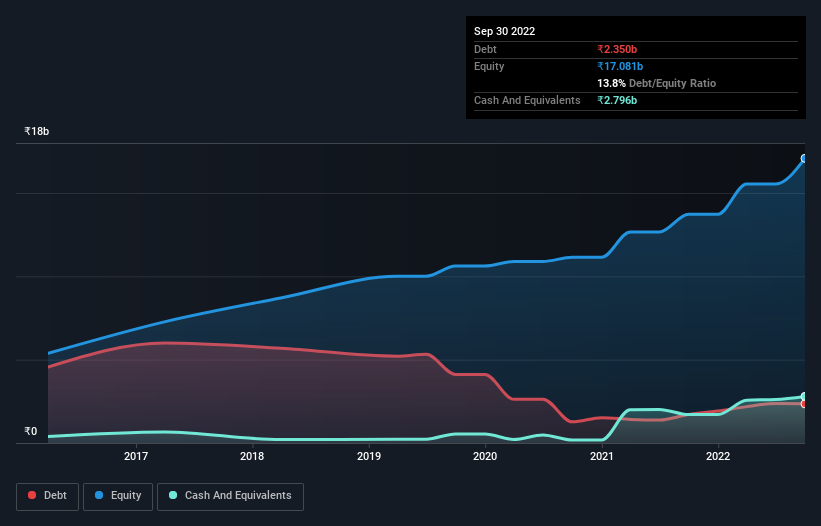- India
- /
- Paper and Forestry Products
- /
- NSEI:CENTURYPLY
Century Plyboards (India) (NSE:CENTURYPLY) Could Easily Take On More Debt

Some say volatility, rather than debt, is the best way to think about risk as an investor, but Warren Buffett famously said that 'Volatility is far from synonymous with risk.' When we think about how risky a company is, we always like to look at its use of debt, since debt overload can lead to ruin. We can see that Century Plyboards (India) Limited (NSE:CENTURYPLY) does use debt in its business. But the real question is whether this debt is making the company risky.
When Is Debt A Problem?
Generally speaking, debt only becomes a real problem when a company can't easily pay it off, either by raising capital or with its own cash flow. In the worst case scenario, a company can go bankrupt if it cannot pay its creditors. However, a more common (but still painful) scenario is that it has to raise new equity capital at a low price, thus permanently diluting shareholders. By replacing dilution, though, debt can be an extremely good tool for businesses that need capital to invest in growth at high rates of return. When we examine debt levels, we first consider both cash and debt levels, together.
Our analysis indicates that CENTURYPLY is potentially overvalued!
What Is Century Plyboards (India)'s Net Debt?
The image below, which you can click on for greater detail, shows that at September 2022 Century Plyboards (India) had debt of ₹2.35b, up from ₹1.71b in one year. But on the other hand it also has ₹2.80b in cash, leading to a ₹446.1m net cash position.

How Strong Is Century Plyboards (India)'s Balance Sheet?
According to the last reported balance sheet, Century Plyboards (India) had liabilities of ₹6.31b due within 12 months, and liabilities of ₹462.5m due beyond 12 months. Offsetting these obligations, it had cash of ₹2.80b as well as receivables valued at ₹3.81b due within 12 months. So it has liabilities totalling ₹165.6m more than its cash and near-term receivables, combined.
Having regard to Century Plyboards (India)'s size, it seems that its liquid assets are well balanced with its total liabilities. So while it's hard to imagine that the ₹125.3b company is struggling for cash, we still think it's worth monitoring its balance sheet. While it does have liabilities worth noting, Century Plyboards (India) also has more cash than debt, so we're pretty confident it can manage its debt safely.
In addition to that, we're happy to report that Century Plyboards (India) has boosted its EBIT by 30%, thus reducing the spectre of future debt repayments. When analysing debt levels, the balance sheet is the obvious place to start. But it is future earnings, more than anything, that will determine Century Plyboards (India)'s ability to maintain a healthy balance sheet going forward. So if you're focused on the future you can check out this free report showing analyst profit forecasts.
Finally, a business needs free cash flow to pay off debt; accounting profits just don't cut it. While Century Plyboards (India) has net cash on its balance sheet, it's still worth taking a look at its ability to convert earnings before interest and tax (EBIT) to free cash flow, to help us understand how quickly it is building (or eroding) that cash balance. Looking at the most recent three years, Century Plyboards (India) recorded free cash flow of 48% of its EBIT, which is weaker than we'd expect. That weak cash conversion makes it more difficult to handle indebtedness.
Summing Up
We could understand if investors are concerned about Century Plyboards (India)'s liabilities, but we can be reassured by the fact it has has net cash of ₹446.1m. And we liked the look of last year's 30% year-on-year EBIT growth. So is Century Plyboards (India)'s debt a risk? It doesn't seem so to us. Over time, share prices tend to follow earnings per share, so if you're interested in Century Plyboards (India), you may well want to click here to check an interactive graph of its earnings per share history.
If, after all that, you're more interested in a fast growing company with a rock-solid balance sheet, then check out our list of net cash growth stocks without delay.
New: AI Stock Screener & Alerts
Our new AI Stock Screener scans the market every day to uncover opportunities.
• Dividend Powerhouses (3%+ Yield)
• Undervalued Small Caps with Insider Buying
• High growth Tech and AI Companies
Or build your own from over 50 metrics.
Have feedback on this article? Concerned about the content? Get in touch with us directly. Alternatively, email editorial-team (at) simplywallst.com.
This article by Simply Wall St is general in nature. We provide commentary based on historical data and analyst forecasts only using an unbiased methodology and our articles are not intended to be financial advice. It does not constitute a recommendation to buy or sell any stock, and does not take account of your objectives, or your financial situation. We aim to bring you long-term focused analysis driven by fundamental data. Note that our analysis may not factor in the latest price-sensitive company announcements or qualitative material. Simply Wall St has no position in any stocks mentioned.
About NSEI:CENTURYPLY
Century Plyboards (India)
Manufactures and sells plywood, laminates, decorative veneers, medium density fiber boards (MDF), pre-laminated boards, particle boards, and flush doors in India.
Reasonable growth potential with mediocre balance sheet.
Similar Companies
Market Insights
Community Narratives



